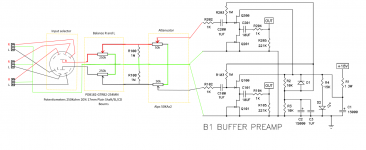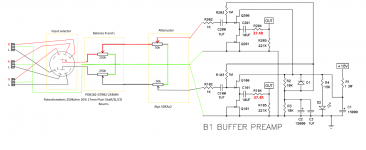thanks guys for your feedback,
I usualy also pay attention to aesthetics and practicality, but yes you are right , i will probably put The PS outside then!
this is the kind of design i like!
those breeze chasis are very nice and quite unexpensive if you have the oportunity to travel to china!
IMG 4155 — imgbb.com
WP 002911 — imgbb.com
WP 002912 1 — imgbb.com
I usualy also pay attention to aesthetics and practicality, but yes you are right , i will probably put The PS outside then!
this is the kind of design i like!
those breeze chasis are very nice and quite unexpensive if you have the oportunity to travel to china!
IMG 4155 — imgbb.com
WP 002911 — imgbb.com
WP 002912 1 — imgbb.com
B1 Selector Switch
Hello All,
While I'm waiting on my chassis to come in I'm now thinking that I'd like to add a selector switch so that I can have more than 2 inputs. I've read in some of the first posts that selectors have been sourced from Hifi Collective and PartsConnexion. I found this one locally and it's also sold on Mouser. Would it be ok?
56D36-01-2-AJN Grayhill | Mouser Canada
I'm not sure exactly the type I need and would like some help and suggestions for a reasonably priced non exotic switch.
Thank You!
Hello All,
While I'm waiting on my chassis to come in I'm now thinking that I'd like to add a selector switch so that I can have more than 2 inputs. I've read in some of the first posts that selectors have been sourced from Hifi Collective and PartsConnexion. I found this one locally and it's also sold on Mouser. Would it be ok?
56D36-01-2-AJN Grayhill | Mouser Canada
I'm not sure exactly the type I need and would like some help and suggestions for a reasonably priced non exotic switch.
Thank You!
Hi All,
i am thinking to add :
input selector,
balance Pot,
Pot attenuator,
any obvious mistake in my sketch?
thank in advance guys!
Balance attenuator — imgbb.com
i am thinking to add :
input selector,
balance Pot,
Pot attenuator,
any obvious mistake in my sketch?
thank in advance guys!
Balance attenuator — imgbb.com
Attachments
Last edited:
Hi Zen,
i am mainly going to use the B1 with A FirstWatt M2 Clone, which has a imput impedance of 100K.
i was also reading ... you are going same direction than Papa, but 22-51R isn't that too low?
B1 Buffer Preamp
Thanks!
i am mainly going to use the B1 with A FirstWatt M2 Clone, which has a imput impedance of 100K.
i was also reading ... you are going same direction than Papa, but 22-51R isn't that too low?
B1 Buffer Preamp
Thanks!
that's idiot proof part , Papa put there as protection , taking in account that B1 was commercial product , with all possible consequennces
however , when I'm making some gadget , I'm only idiot going to use it , so why not optimize it ......
you can omit that resistor completely , meaning - you can put short instead
however , when I'm making some gadget , I'm only idiot going to use it , so why not optimize it ......
you can omit that resistor completely , meaning - you can put short instead
i'm currently gathering parts to build a B1 buffer. now i'm trying to find out which DPDT switch to order for input switching. NKK makes nice toggles. there's the normal version rated at 6A and the "fancy" one rated at 0.4VA with gold plated contacts. would it make any difference witch one i use for input switching?
here's the pdf with the NKK toggle switches: NKK Toggles
here's the pdf with the NKK toggle switches: NKK Toggles
B1 selector switches
Characteristics to look for in a switch for line-level work include:
Silver plated contacts. Yes, gold is prettier and doesn't oxidize as quickly, however silver has always sounded a lot better than gold, and its' oxide is very soft and designed to be displaced by the action of the switch contacts.
Douglass Sax, of The Mastering Lab, says he can always hear a gold contact in an audio signal chain! I'm not sure I can, but Doug has done some really fine work in his day. It has always amused me to see all of the gold in use nowadays, just another example of manufacturers' fashion statements at work.
Secondly, switches should preferably be make-before-break, to avoid the possibility of a nasty pop occurring at the moment of switching. You can probably get away with break-before-make if your sources are free of any trace of DC on the outputs.
Characteristics to look for in a switch for line-level work include:
Silver plated contacts. Yes, gold is prettier and doesn't oxidize as quickly, however silver has always sounded a lot better than gold, and its' oxide is very soft and designed to be displaced by the action of the switch contacts.
Douglass Sax, of The Mastering Lab, says he can always hear a gold contact in an audio signal chain! I'm not sure I can, but Doug has done some really fine work in his day. It has always amused me to see all of the gold in use nowadays, just another example of manufacturers' fashion statements at work.
Secondly, switches should preferably be make-before-break, to avoid the possibility of a nasty pop occurring at the moment of switching. You can probably get away with break-before-make if your sources are free of any trace of DC on the outputs.
Last edited:
Use the smaller one. Don't worry about contact material. The smaller one will be easier to use, nicer to touch, and more appropriate for the teeny signals of sources.
well, the size would be the same. just the rating and the contact material are different. maybe it's smaller or more delicate on the inside since it's rating is so much lower. the data sheet says one is for power level and the other for logic level ..... whatever that means (can you tell i'm a newbie?
- Home
- Amplifiers
- Pass Labs
- B1 preamp build thread

